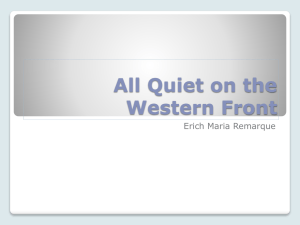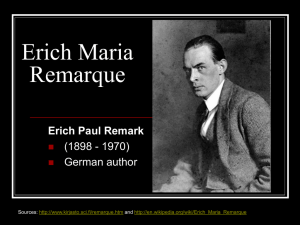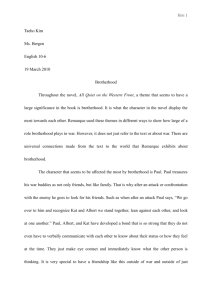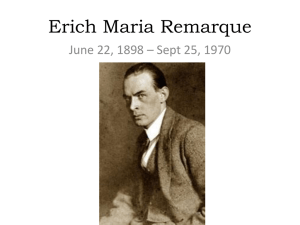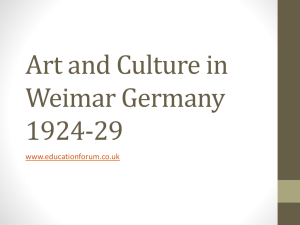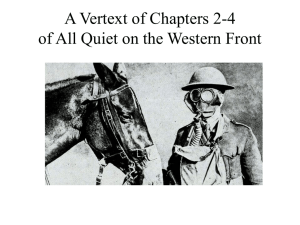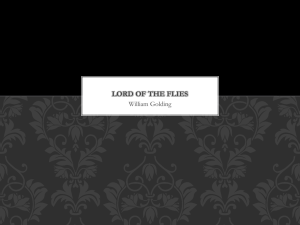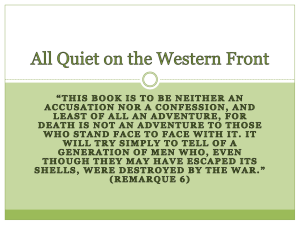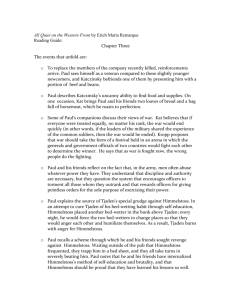All Quiet on the Western Front
advertisement
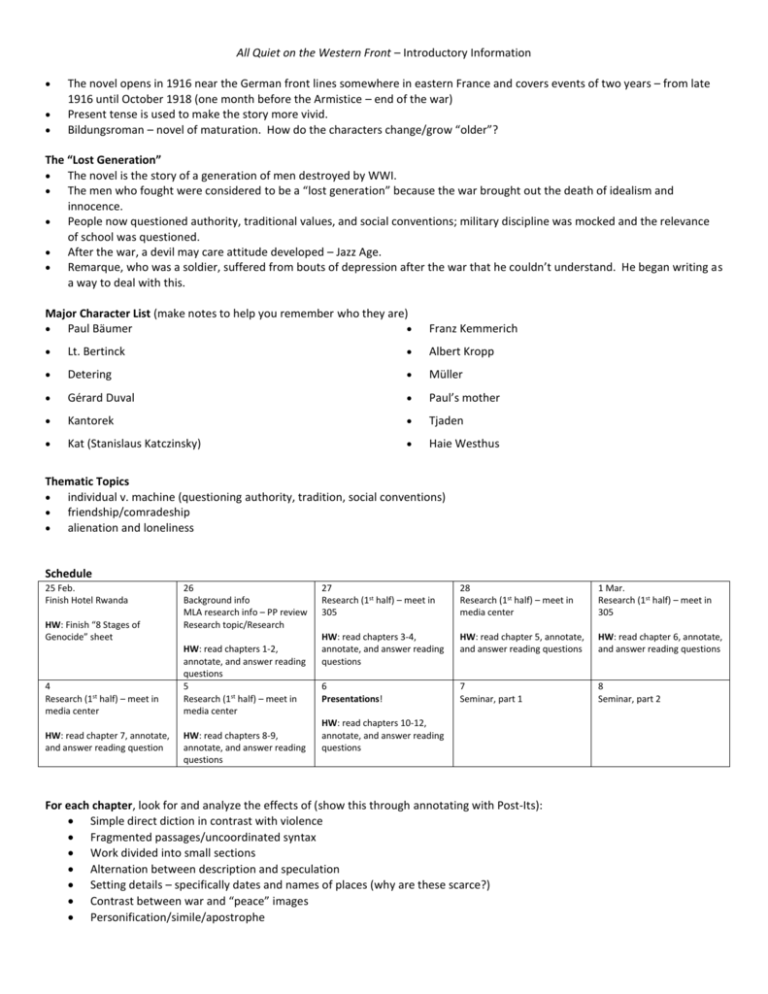
All Quiet on the Western Front – Introductory Information The novel opens in 1916 near the German front lines somewhere in eastern France and covers events of two years – from late 1916 until October 1918 (one month before the Armistice – end of the war) Present tense is used to make the story more vivid. Bildungsroman – novel of maturation. How do the characters change/grow “older”? The “Lost Generation” The novel is the story of a generation of men destroyed by WWI. The men who fought were considered to be a “lost generation” because the war brought out the death of idealism and innocence. People now questioned authority, traditional values, and social conventions; military discipline was mocked and the relevance of school was questioned. After the war, a devil may care attitude developed – Jazz Age. Remarque, who was a soldier, suffered from bouts of depression after the war that he couldn’t understand. He began writing as a way to deal with this. Major Character List (make notes to help you remember who they are) Paul Bäumer Franz Kemmerich Lt. Bertinck Albert Kropp Detering Müller Gérard Duval Paul’s mother Kantorek Tjaden Kat (Stanislaus Katczinsky) Haie Westhus Thematic Topics individual v. machine (questioning authority, tradition, social conventions) friendship/comradeship alienation and loneliness Schedule 25 Feb. Finish Hotel Rwanda HW: Finish “8 Stages of Genocide” sheet 4 Research (1st half) – meet in media center HW: read chapter 7, annotate, and answer reading question 26 Background info MLA research info – PP review Research topic/Research HW: read chapters 1-2, annotate, and answer reading questions 5 Research (1st half) – meet in media center HW: read chapters 8-9, annotate, and answer reading questions 27 Research (1st half) – meet in 305 28 Research (1st half) – meet in media center 1 Mar. Research (1st half) – meet in 305 HW: read chapters 3-4, annotate, and answer reading questions HW: read chapter 5, annotate, and answer reading questions HW: read chapter 6, annotate, and answer reading questions 6 Presentations! 7 Seminar, part 1 8 Seminar, part 2 HW: read chapters 10-12, annotate, and answer reading questions For each chapter, look for and analyze the effects of (show this through annotating with Post-Its): Simple direct diction in contrast with violence Fragmented passages/uncoordinated syntax Work divided into small sections Alternation between description and speculation Setting details – specifically dates and names of places (why are these scarce?) Contrast between war and “peace” images Personification/simile/apostrophe Complete reading questions for each chapter (on back). Reading Questions Chapter 1 1. 2. How does the author “set the stage” at the beginning of the novel? What details in the opening chapter helped to make the setting especially vivid? WHY does the author do this at the beginning? A paradox is an apparent contradiction that is actually true. Explain the paradoxical statement that Paul makes about Kemmerick: “He is it still and yet it is not he any longer.” Chapter 6 1. In what sense do you think that the incidents in this chapter show that the men have indeed “become wild beasts,” as Paul claims? In what ways do you think they still preserve some human characteristics, despite the horrors of trench warfare? 2. What conclusion about warfare do you think Remarque conveys when he sums up the outcome of the battle in this chapter: a few hundred yards of territory have changed hands, and a man is lying dead on every yard? Chapter 2 1. 2. Paul says that he and the other young men of his generation have become a “waste land.” What has led him to this bleak conclusion? Remarque uses one of his favorite structural techniques in chapter two: the juxtaposition of sharply contrasting scenes or episodes. How does the mood of the first half of the chapter, which focuses on Himmelstoss, contrast with the mood of the second half, which focuses on the death of Kemmerich? Chapter 7 1. Chapter 8 1. What do you think is the author’s purpose in presenting the brief scene between Paul and his father? Could this be scene have been omitted? If so, what would have been lost? 2. At the end of the section in which Paul first describes the Russian prisoners, he thinks, “[T]his is a task that will make life afterward worthy of these hideous years.” What prompts these thoughts? To what task do you think Paul refers? How do these thoughts further develop Remarque’s theme of comradeship? Chapter 3 1. Kat says that he thinks that “man is essentially a beast, only he butters it over like a slice of bread with a little decorum.” How does he support this opinion? How do you react to Kat’s outlook? 2. This chapter explores the feelings and attitudes of the common soldier about World War I. Can you think of any parallels to these feelings from information you have about other wars – for examples, the Civil War, World War II, the Vietnam War, the Persian Gulf conflict, the Iraqi War? Chapter 9 1. How does the Gérard Duval episode represent a watershed, or turning point, in Paul’s life? What situation does he confront for the first time? 2. How does Remarque use suspense in the Gérard Duval episode? Chapter 4 1. Apostrophe is a figure of speech in which a speaker directly addresses an absent or dead person, a deity, an abstract quality, or something nonhuman as if it were present and capable of responding. Why do you think Paul is so emotional in his apostrophe to the earth in Chapter 4? What does the earth mean to a soldier? 2. One of the most vivid, memorable episodes in the novel is the description of the wounded horses in this chapter. How can the horses be regarded as symbolic – that is, as standing both for themselves literally and for something beyond themselves? 3. Style is the way a writer uses language to express his or her thoughts. Reread the paragraph on the last page of chapter 4 that begins, “Monotonously the lorries sway…” What examples of repetition can you identify? What metaphor concludes the paragraph? What kind of mood does Remarque’s style here help to establish? Chapter 5 1. 2. Remarque uses another striking example of a paradox when he has Paul say that what the young men know – how to play cards, to swear, and to fight – is “Not much for twenty years; - and yet too much for twenty years.” How would you explain the paradox here? How does Remarque vary tone in this chapter? Consider these episodes: the delousing of the men the discussion of peacetime, and the men’s talk about their future plans, the conflict between Himmelstoss and Tjaden, and the episode of the goose. What do you think lies behind Paul’s growing sense of anxiety and alienation during his weeks on leave? Consider his interactions with the Major, the German-master, and his own mother. Chapter 10 1. Remarque uses a number of vignettes to make the scene at the Catholic Infirmary concrete and vivid. Consider the episodes involving (a) Josef Hamacher, (b) curly-headed Peter, (c) the youthful musician, and (d) Lewandowski. How does each brief sketch contribute to the setting and mood of the narrative? Chapters 11-12 1. What was your emotional reaction to the conclusion of the novel? 2. Kemmerich’s boots reappear in chapter 11. From what Paul says about them, how might Remarque intend them to be symbolic? What might they symbolize? 3. What is the effect of Remarque’s use of repetition in that passage where Paul describes the fighting during the summer of 1918? 4. Identify two or three examples of irony in chapters 11 and 12. How does each use of irony affect the tone and atmosphere of the novel’s concluding pages? 5. In what sense could you argue that the climax of All Quiet on the Western Front is the death of Kat at the end of chapter 11? 6. In the description of Paul’s death in the last two paragraphs, what is the dominant tone?
